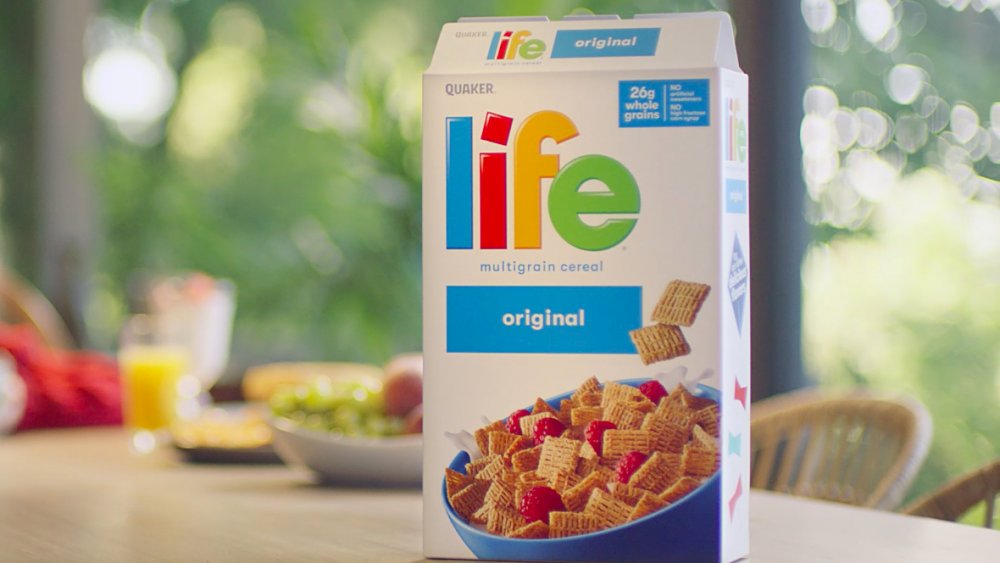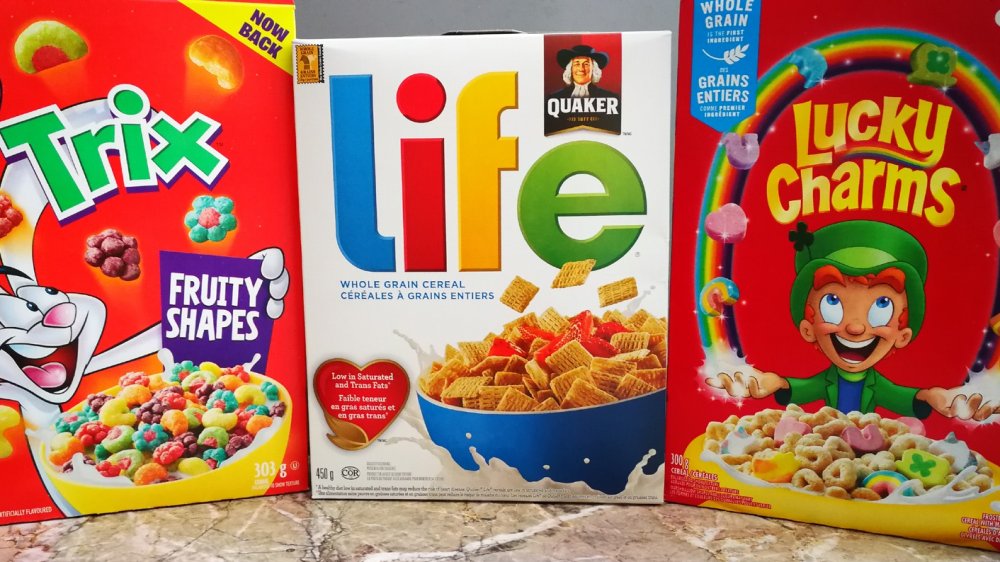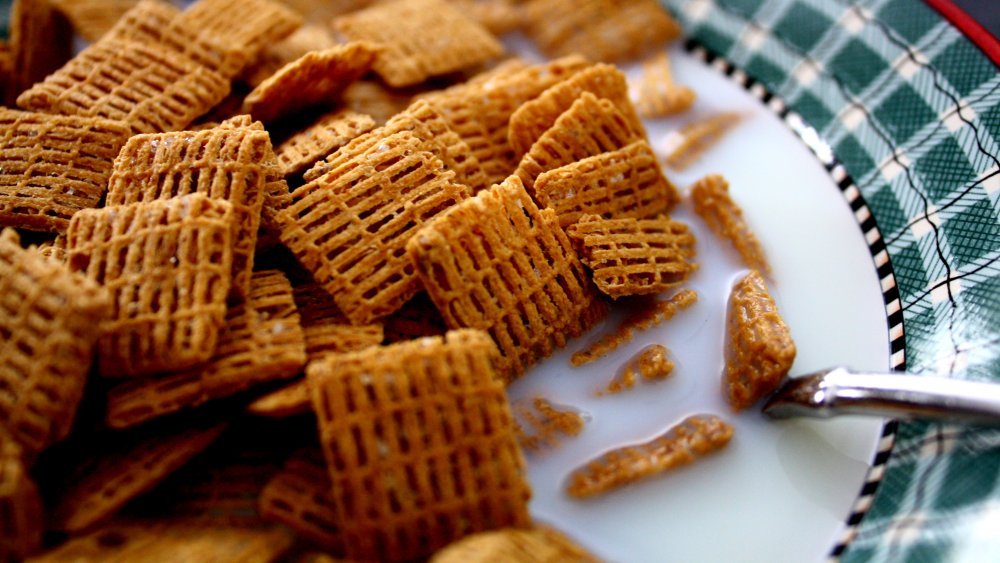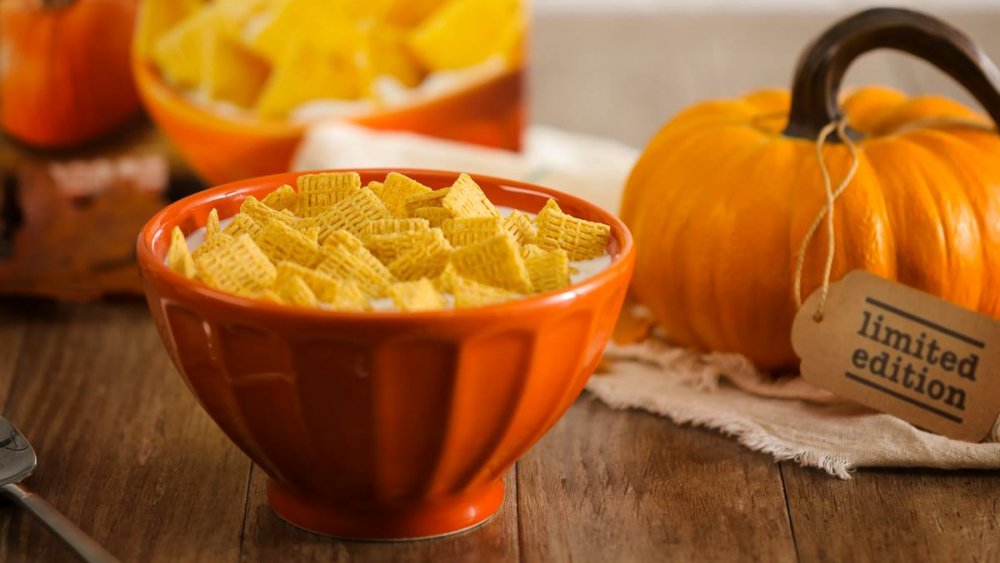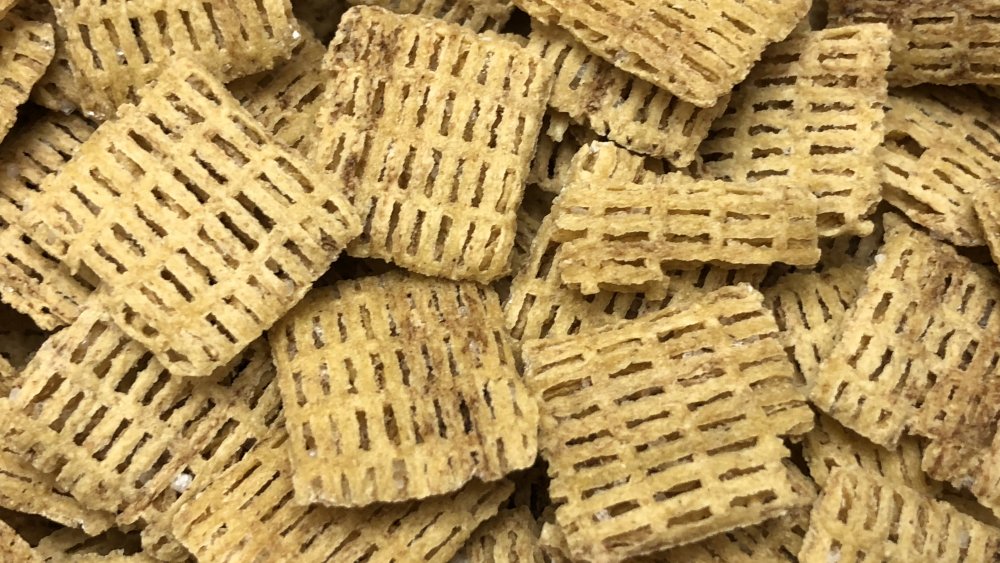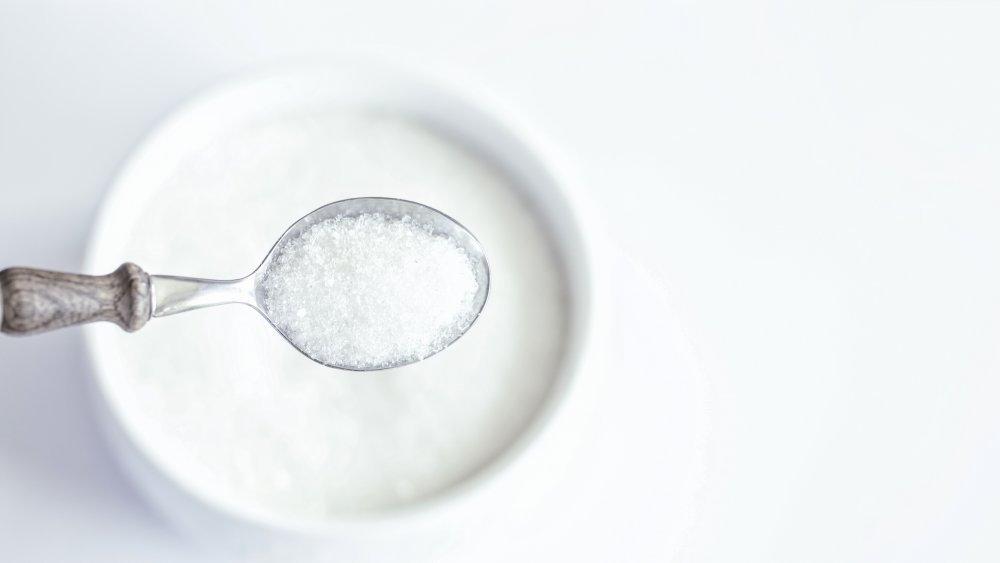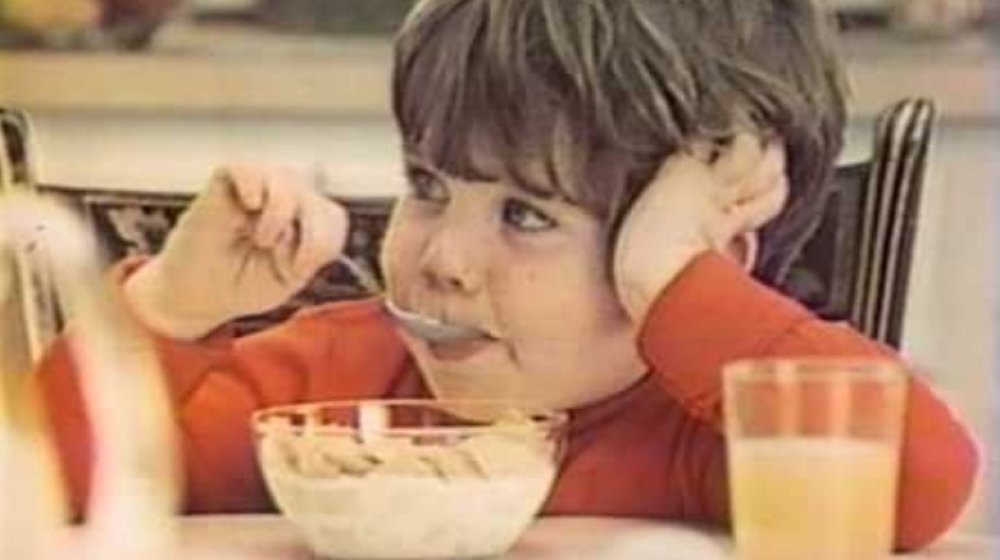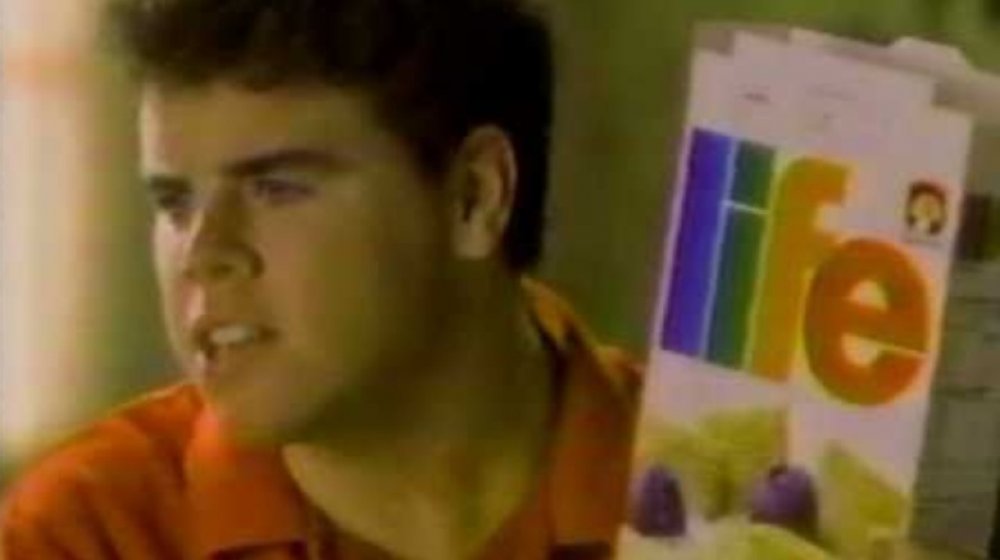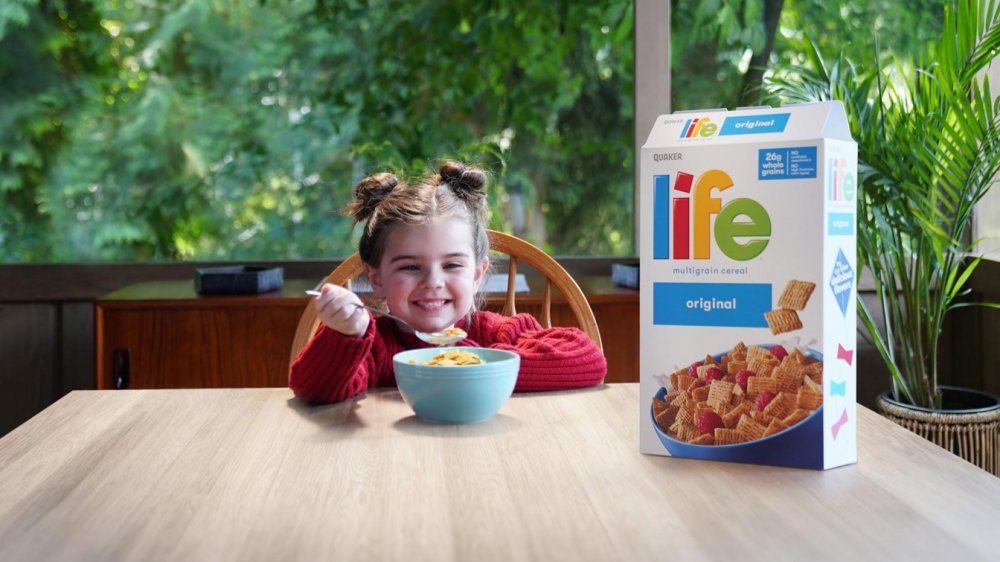The Untold Truth Of Life Cereal
Picking a cereal isn't exactly life or death, though all the many options can bring on some pretty overwhelming feelings of indecision. Over the years, it seems like the choices in the cereal aisle just continue to grow, and you're faced with so many options as you stand there with colorful boxes staring back at you. Do you opt for something sugary-sweet? Is it best to go with a whole grain option or something packed with fiber? You may also consider the newest recipe on the shelf or one of those age-old staples, like Life Cereal.
Quaker Oats' Life Cereal has been around for a long time and yet it continues to show up in kitchen pantries. Its square, slotted appearance and simple multigrain taste has become widely known, and Life has continued to market to both kids and adults alike. But what else is there to this uniquely named cereal? Mashed took a deep dive into the iconic cereal's past and present and what we discovered was surprising, to say the least. This is the untold truth of Life Cereal.
Life Cereal has been around for decades
You may remember enjoying a bowl of Life Cereal as a child or perhaps you currently swear by eating it every morning. It's a staple in many households and it's been that way for years and years.
Life Cereal, owned by Quaker Oats, debuted in 1961, but the company became known as a cereal manufacturer long before that. In 1877, Quaker Oats registered as the very first trademark for a breakfast cereal, according to the manufacturer, and soon began marketing their oatmeal for breakfast. In 1888, Quaker Oats united with six other major oat millers in the United States, forming the American Cereal Company.
Many years later, Quaker Oats offered a cold cereal option, thus giving life to Life. The cereal was introduced on the market in its original flavor and its popularity has only continued to grow from there. In 2019 alone, 6.5 million Americans consumed between one and four servings of Life Cereal and nearly 1.5 million Americans consumed 10 servings or more, according to U.S. Census and Simmons National Consumer Survey data calculated by Statista.
Quaker Oats sells a lot of Life Cereal
Since Life Cereal has been around in family households for quite a few decades, it's not surprising that Quaker has sold a lot of the product over the years. As of 2018, Life Cereal was noted as one of the top ten best-selling cereals. Surrounded by a booming breakfast business with Americans eating $8.5 billion worth of cereal in 2017, staying within the top ten rankings is no small feat.
According to Kiplinger, the annual number of boxes of Life Cereal sold for the 2018 fiscal year held right around 58 million, or $177.5 million in cereal sales. The numbers had dipped near four percent year-over-year, but Life Cereal was still holding strong. As Quaker makes and sells plenty of breakfast options from oatmeal to bars and cereals, Life Cereal still manages to account for almost one-third of the total U.S. ready-to-eat cereal sales for the brand.
Life Cereal dabbles in different flavors
When Life Cereal originally started out, it was here to be everybody's best cereal friend, offering the benefits of multigrain with a sprinkle of sugar to appease kids and adults alike. But, for some, Life's original flavor may have seemed a bit lackluster.
Quaker Oats' Life Cereal has combatted that over the years by introducing a few additional staple options to kick up the flavor profiles. Following the introduction of the original Life Cereal, Cinnamon and Vanilla varieties hit store shelves, upping the flavor profile a notch. These days, you can also find Life in Strawberry, which Quaker Oats claims is as "sweet as a summer day."
Life Cereal has also debuted multiple seasonal flavors. In 2016, Quaker Oats introduced Life in Pumpkin Spice and in 2017, Gingerbread Spice. Although Life started as a fairly basic cereal, it definitely plays well with additional flavor options, making us all wonder what will come next in the Life Cereal line-up.
Life Cereal is surprisingly low in fiber
There are surely people out there who choose to eat Life Cereal solely because it seems to be a healthy option compared to many other cereals on the market. The box boasts 26 grams of whole grains per one-cup serving, so there must be something good to it, right? Often the idea of consuming whole grains translates to the idea that you're getting a lot of fiber. After all, whole grains means you're getting the entire grain, rather than a refined version that removes a lot of the important nutrients such as fiber.
Despite that theory, though, Life Cereal contains only 3 grams of fiber per one-cup serving. A cereal like Kellogg's Raisin Bran, however, contains over twice that amount at 7 grams per one-cup serving. The recommendation put forward by the U.S. Food and Drug Administration for fiber consumption is 25 grams per day, so even though Life boasts a great deal of whole grains, one serving is not making any significant dent in the daily recommended value of fiber you need.
Life Cereal is made with artificial coloring
When you think of cereals such as Froot Loops or Cap 'n Crunch, it certainly would not be surprising to learn they contain artificial food coloring. After all, hues of pinks and turquoise and lime green don't typically come naturally in the food world. But Life Cereal? That might be a bit shocking.
When you pour Life Cereal out of the box and into a bowl, it's generally a light brown color and it would be reasonable to assume that color comes from the grains used in the recipe. But as it turns out, Life Cereal gets a bit of help from artificial food coloring.
Life Cereal's Original flavor, for example, contains Yellow 5 and Yellow 6. Yellow 5 is an FDA-approved artificial food color that has been added to food since 1969, according to Healthline. It adds a sunny yellow hue while Yellow 6 adds in a more orange tone, giving Life Cereal its distinct coloring. And while both are allowed for use and pretty common in cereals — as well as processed candies, baked goods, and more — it is quite surprising to find artificial colors in an oat-colored multigrain cereal.
Life Cereal has more sugar than you think
Just looking at a box of Life Cereal at first glance makes you feel like you're making a healthy choice. After all, it is a seemingly heart-healthy option made with whole grains and offers a great source of vitamins. However, it's important to take a look at the sugar content of whichever cereal you're buying.
When it comes to Life Cereal, one might think the sugar content would be similar to Cheerios, with just a small amount of one gram per serving, but that's not the case. One one-cup serving of Life Cereal has 8 grams of sugar — all of which are added sugars. And while that doesn't seem like an astronomical amount, the daily recommended amount of sugar consumption per day is 37.5 grams for men and 25 grams for women. If you eat a cereal with added sugar for breakfast, it will be all too easy to consume too much sugar throughout the rest of the day.
Life Cereal ran the same ad for a decade
When Life Cereal aired its television commercial featuring "Mikey," Quaker Oats probably didn't know it would be as popular as it became or that it would hold strong for so many years. Sure, a company always hopes to launch an effective commercial, but this success was on a different level.
The ad aired in 1972 featuring three brothers (who were actually brothers in real life) debating who would try the new cereal first at the breakfast table. Two of the brothers hand the cereal down to little Mikey and as he tries the cereal, one of the brothers exclaims, "He likes it! Hey Mikey!" and that phrase held strong for Life Cereal lovers and newbies to the product for a very long time.
The commercial has been described as iconic and it was even inducted into the TV Commercial Hall of Fame and earned a Clio Award, according to Forbes. The commercial continued to run for more than ten years from its debut in the early '70s, Campaign revealed, and was even recreated it in 2000. Who knew one child could make such an impact on the cereal business?
There were rumors claiming Life Cereal's Mikey died
When it comes to food commercials, Life Cereal definitely took top prize for its "Hey Mikey!" commercial debuting in '70s. It won an award, remained on air for years, and we can only imagine how often the iconic phrase was quoted in American households. But the person who played Mikey in the memorable commercial, child actor John Gilchrist, became the subject of unfortunate gossip by 1979.
As rumor had it, Mikey lost his life because he had mixed too much Coca-Cola with Pop Rocks candy, causing his stomach to explode. According to Thrillist, his mother even got a call at home with someone expressing their deepest sympathies for her loss.
Despite Gilchrist being alive and well, the rumor spread quickly nationwide, causing Pop Rocks sales to tank after only launching the product in 1975. Fans eventually got to see for themselves that Gilchrist was not dead as he reprised his role as Mikey in a 1986 Life commercial. "The whole story was so ridiculous," Gilchrist told Thrillist. Not only can Pop Rocks mixed with soda not cause a person's stomach to explode, Mikey was — and is, at least as of 2017 — just fine.
Life Cereal is owned by PepsiCo
Quaker Oats certainly stands on its own merit and has been a preferred name-brand cereal in many households for well over a century. After all, it basically launched the idea of breakfast cereal. But it may be surprising to know that Quaker Oats is actually owned by giant beverage company PepsiCo.
Quaker Oats certainly started out on its own, but over the years the company managed to develop ties with the beverage industry. In 1983, Quaker Oats acquired the Gatorade brand, according to The New York Times, and in 1993, Quaker purchased the Snapple beverage brand for $1.7 billion. At the time, Coca-Cola had been vying for the beverage line, but Quaker Oats outbid the soda company.
In 2000, Snapple was purchased from Quaker Oats and in that same year, PepsiCo acquired Quaker Oats for $13.4 billion, ABC News reported, mainly with the goal of adding the ever-popular Gatorade brand to its roster of non-carbonated beverage options. And ultimately, brands under the Quaker Oats umbrella such as Life Cereal, along with other staples like Chewy Granola Bars, went with it.
